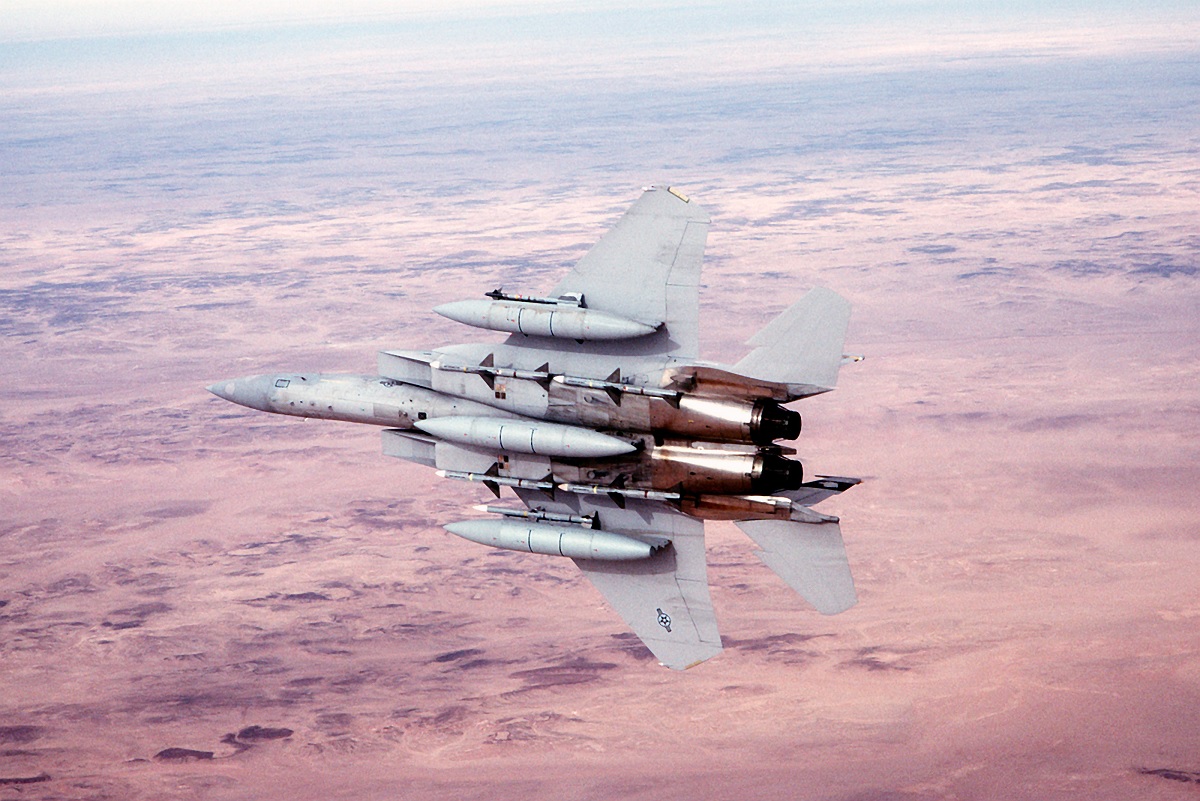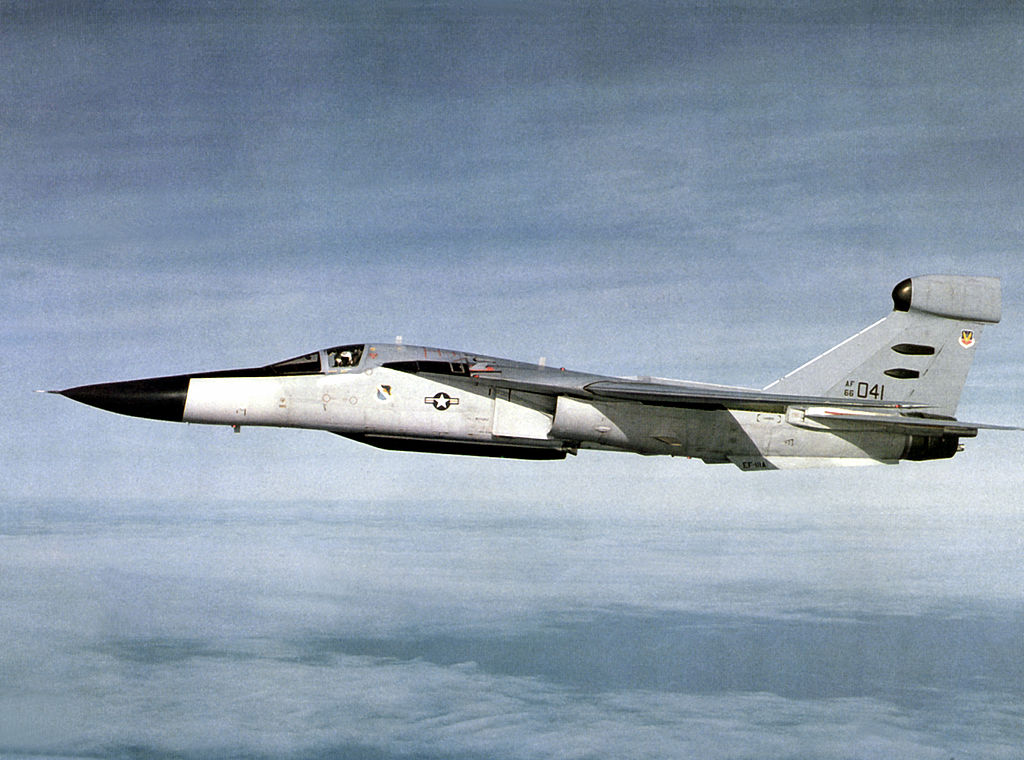“Another aircraft hit the ground at my ‘two o’clock’ about three miles away from where the first Mirage had come down. The pilot of the number two Mirage had gone into a hard right turn to the west in an effort to get away from us, suffered spatial disorientation and then flown into the ground,” Capt Robert ‘Cheese’ Graeter, F-15C pilot
The F-15C Eagle is an all-weather, extremely maneuverable, tactical fighter designed to permit the U.S. Air Force (USAF) to gain and maintain air supremacy over the battlefield.
F-15C and D models were deployed to the Persian Gulf in 1991 in support of Operation Desert Storm (ODS) where they proved their superior combat capability. The F-15C fighters in fact accounted for 34 of the 37 USAF air-to-air victories.
In the early hours of Jan. 17, 1991, the 58th Tactical Fighter Squadron (TFS) launched two flights of four F-15Cs, operating with the call-signs ‘Citgo 61′ to ’64’ and ‘Pennzoil 61′ to ’64’.
As told by Steve Davies in his book F-15C Eagle Units in Combat, with ‘Pennzoil’ flight approximately 100 miles ahead to the northeast of Baghdad, and committed to intercepting the two groups of ‘bogeys’ called out by AWACS, `Citgo’ flight pushed northwest towards Mudaysis AB — a small airfield used by forward-deployed Iraqi Air Force (IrAF) assets, and with an alert component of Mirage F1EQs.
Capt Robert ‘Cheese’ Graeter, the same pilot who had flown cover for U.S. Navy P-3s during the KAL 007 incident some eight prior – was leading the flight in F-15C 85-0105, call-sign ‘Citgo 61’.
`Citgo’ was tasked to run directly at Mudaysis, then to turn northwest towards H2 and H3 airfields. Once there, Graeter was to set up a Barrier CAP (BARCAP) of two 25-mile legs between H2/H3 and Mudaysis, with a pair of Eagles on each leg. This would allow them to commit against IrAF fighters ascending from either base:
“As we ran towards Mudaysis, I could see all of the F-15Es on Mode 4 (IFF). We could also see a CAP of MiG-29s 50 to 60 miles northwest of Mudaysis and about 85 miles from us, but they were all we could see. I was pretty confident that the MiG-29s I could see were the same ones that AWACS was talking about because I was not getting a Mode 4 response in front of them. We were closing the distance on them, but we were not really running an intercept on them just yet.”

As `Citgo’ closed the gap, Graeter began to pick up new contacts over the top of Mudaysis: “I got a contact at low altitude, which was my search area of responsibility. I had my radar seen to search from ground level upwards to about 18 miles in front of me. Maw [Lt Scott Maw, ‘Citgo 62’] had the opposite area and was looking from 50,000 ft downwards. At 25 miles, my first contact appeared to be at about 1500 ft AGL, (Above Ground Level), on a departure heading northwest. He started a left-hand turn to the southeast, so I broke the lock and observed additional jets taking off. I could now see three contacts, all in a few miles trail.”
Maw and Graeter melded their radar images and sorted their targets (both Mirage F 1EQs) in order to execute a coordinated plan of attack. At 17 miles, Graeter locked up the lead target and Maw concentrated on the trailing jet: `I still had no idea what type of threat they were, but AWACS was getting information from Rivet Joint and was calling “pop-up threats”, which meant that there were hostiles within 25 miles. I learned later from listening to the tapes that the AWACS controller was also referring to them as bandits, although I didn’t know that at the time. I was therefore working through my NCTR [Non-Cooperative Target Recognition] and IFF EID [Enhance Identification] “tree”, manually dialing in my Mode 3 7600 to see if anyone was “squawking” a comm failure, but getting no return.
“In the meantime, I was having to ramp it downhill from 30,000 ft to the ‘mid-20s’ because my radar look-angle was getting a bit steep. I finally finished my EID matrix at about ten miles or so, but I was still asking AWACS for confirmation of the status of this guy [Graeter never heard the original AWACS call confirming that the target was a bandit]. I got no response, so I went ahead and shot him from a distance of ten miles.”
Graeter watched his AIM-7 come off of the right side of the jet, despite telling himself that he wouldn’t: “Our game plan was to shoot and look to see if the rocket motor had fired, and to check that the missile was looking good to intercept. So that’s what I did. I then got back into the cockpit and flew my F-pole maneuver, executing a 40-degree check turn to the left to give the missile and me some added space. By the time I looked back outside, I could no longer see the missile, and, as the computer told me that the weapon was about to time out, I started to pull my nose back towards the target. That’s when the missile went off.
“I distinctly remember the missile exploding in a conical shape as the charge went off. Everything coming off of it was red hot, so it was easy for me to see this cone of energy. Instantaneously, some four or so miles from me, at a height of 7000 ft, debris started coming from the other direction — southeast — as the target exploded with a really bright flash. Pieces of the jet continued to arc earthwards in flames from the southeast. I called, “Splash”, and Maw confirmed that he could see it.”
Maw was still locked onto the trailing Mirage F1EQ, which was 15 miles ahead of him. The remaining two F-15s in ‘Citgo’ flight, which had fallen back into a 20-mile trail, had already been despatched to the northwest by Graeter after he directed them to H2 and H3. They were to cut off any support that may have been launched in response to these initial engagements between the IrAF and the F-15Cs. Neither found anything of interest, so they executed a CAP over the original BARCAP coordinates instead. Capt Graeter recalled:
“I checked to the northwest, went to Auto Guns, and slewed the radar down, looking for the downed Mirage’s wingman. As I listened to Maw calling his bandit at 330 degrees for 13 miles, there was another explosion — the jet I had just shot had impacted the ground. Almost immediately afterward, another aircraft hit the ground at my ‘two o’clock’ about three miles away from where the first Mirage had come down. I could see the burning jet tumbling and cartwheeling across the desert floor. There was an overcast, so the light from the explosions bounced off of the cloud deck — it was pretty surreal.

“As best as we could tell, the pilot of the number two Mirage had gone into a hard right turn to the west in an effort to get away from us, suffered spatial disorientation, and then flown into the ground.”
By now the pilot of a third Mirage that had taken off from Mudaysis had a fairly good idea that he was outclassed and in a perilous situation. The Iraqi quickly headed back north towards his base putting Maw in a ten-mile tail-chase situation. Several factors, combined to prevent Graeter, who was closer than Maw by several miles, from going after the fleeing Mirage — Roland surface-to-air missile (SAM) indications were coming from the vicinity of Mudaysis and he was also detecting SAM activity in the H2/H3 airfield complex to the northwest. An excessive look-down radar angle was also required to detect the low-flying Mirage, and he did not want to light afterburners to give chase in case he attracted attention to himself.
For the first time, the odds were stacked in the Mirage pilot’s favor. Graeter told Davies that to this day, he would have been hard-pressed to have got him, “even with AMRAAM.”
‘Citgo’ flight learned from the wing’s intelligence officer upon landing at Tabuk (King Faisal AB) that their quarry had been Mirage F1EQs. Graeter was officially awarded credit for the second Mirage as a `maneuvering kill’ one week later. Suggestions that credit for this victory should have been attributed to an EF-111A, which allegedly out-maneuvered the Mirage after being pursued by it, were dismissed as ‘highly unlikely’ by the MiG killers interviewed by Davies. Graeter himself recalled that there were no EF-111As in the area that night, the only Coalition aircraft nearby being F-15Es.
Upon landing back at Tabuk, Graeter’s thoughts turned to the Iraqi pilot he had just killed: “There was no chance of surviving a hit by a big missile-like AA-10 (which the IrAF used) or AIM-7. You were not going to bail out, you were not going to make a radio call — you were going to turn into dust. That AIM-7 warhead absolutely shredded the Mirage. It’s designed to cut the cockpit into shreds when fired in a head-on engagement — the pilot never knew what hit him. When I got back, debriefed with the intel people and then headed to the food hall for breakfast. Chuck Magill, who had just got up in preparation for his day flight, told me later that he could tell from my face that this was not all fun and games.”
F-15C Eagle Units in Combat is published by Osprey Publishing and is available to order here.



